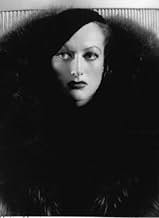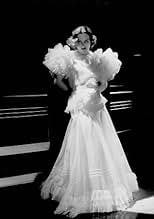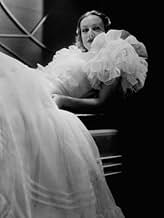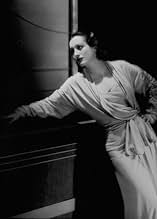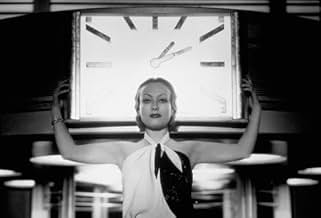A socialite begins a shipboard romance with a wealthy man, but is blackmailed by a former lover.A socialite begins a shipboard romance with a wealthy man, but is blackmailed by a former lover.A socialite begins a shipboard romance with a wealthy man, but is blackmailed by a former lover.
- Director
- Writers
- Stars
- Awards
- 4 wins total
Sidney Bracey
- Waiter
- (uncredited)
Edward LeSaint
- Dr. Sanders
- (uncredited)
Edgar Norton
- Darrow's Butler
- (uncredited)
Lee Phelps
- Dennis, Darrow's Chauffeur
- (uncredited)
Harry Stubbs
- Ship's Steward
- (uncredited)
Charles Williams
- Reporter
- (uncredited)
- Director
- Writers
- All cast & crew
- Production, box office & more at IMDbPro
Featured reviews
... unlike so many lost or unavailable films. The plot initially seems not so unusual, especially for a Joan Crawford MGM vehicle of the 1930's. Joan plays a fabulously wealthy playgirl living in South America who decides to return home for a multitude of reasons - she wants to turn over a new leaf, she wants to make up with the mother (May Robson) who has been pushing her away all her life, but most of all she wants to get out of the grasp of a possessive lover (Nils Asther) that is smothering her and objectifying her to the point that she is frightened. She takes a ship home to New York, and on the way there falls in love with the charming heir Hale Darrow (Robert Montgomery). The two become engaged with the press waiting to snap their pictures as the boat docks, but as the picture is snapped, what does Letty see but the possessive lover she thought she left in South America, literally licking his chops for her and waiting for her to land.
Young Darrow knows nothing of Letty's past, Letty's mom still wants nothing to do with her, and as for her old lover, he's demanding she continue the affair or else he will publicize some torrid love letters she wrote. How does this all turn out? Quite unexpectedly, I'll tell you that much and I'll also tell you, thank goodness for precode where justice in the movies - as in life - didn't always have the predictable nature of a form letter like it did after 1934.
MGM threw its A-list talent at this one including Joan's gowns by Adrian, Lewis Stone with a short but important part at the end, and some first class character actors. The only thing that doesn't ring quite true is May Robson as Joan's mother. Robson's acting and characterization are perfect, but she was almost 50 years older than Joan, looks it, and it just doesn't seem plausible that they could be mother and daughter with that age difference staring you in the face. Still it's a minor quibble and I'd highly recommend watching it if you ever get the opportunity.
Young Darrow knows nothing of Letty's past, Letty's mom still wants nothing to do with her, and as for her old lover, he's demanding she continue the affair or else he will publicize some torrid love letters she wrote. How does this all turn out? Quite unexpectedly, I'll tell you that much and I'll also tell you, thank goodness for precode where justice in the movies - as in life - didn't always have the predictable nature of a form letter like it did after 1934.
MGM threw its A-list talent at this one including Joan's gowns by Adrian, Lewis Stone with a short but important part at the end, and some first class character actors. The only thing that doesn't ring quite true is May Robson as Joan's mother. Robson's acting and characterization are perfect, but she was almost 50 years older than Joan, looks it, and it just doesn't seem plausible that they could be mother and daughter with that age difference staring you in the face. Still it's a minor quibble and I'd highly recommend watching it if you ever get the opportunity.
So many films of great movie stars are out of circulation for one reason of another. LETTY LYTTON is one of them. I have never seen it, although (from the sound of it it sounds interesting). I can though illuminate something of the background.
Marie Belloc Lowndes is recalled today for one novel (from a short story) entitled "THE LODGER". She was fascinated by crime and wrote books based on famous cases (like a younger contemporary, "Joseph Shearing"). THE LODGER was about the Jack the Ripper murders. Other novels of hers were turned into movies. THE STORY OF IVY became a film with Joan Fontaine as an unscrupulous poisoner (of her husband) - supposedly based on the Maybrick Murder Case of 1889.
LETTY LYTTON was based on the Madeleine Smith poisoning case of 1857 in Glasgow, Scotland. Madeleine was supposed to marry a Mr. William Minnoch, in a marriage approved by her very strict father (a leading architect). But she had been having very close relations with an Emile L'Angelier (foreign sounding for Scotland, but L'Angelier was from the Channel Islands of Great Britain). L'Angelier may have loved Madeleine, but he was also socially attracted to her position in Glasgow. He would not let her drop the relationship. Several times he visited her, and came home ill. The last time he died. Subsequently arsenic was found on his corpse. Love letters written by Madeleine led to her arrest. She was tried, but the jury (despite good reason) was not willing to find her guilty. They did not acquit either. Instead, she was found "Not Proven", which is a verdict on Scotland has. Madeleine eventually married an artist, George Wardle, until their divorce in the 1880s. She became a socialist (one of her friends in London was George Bernard Shaw). She married a second time, emigrated to America, and died in New York City (in the Bronx) in 1926 when in her nineties. She is buried there.
Certainly, in her later years, she did not have the wonderful wardrobe that was Ms Crawford's courtesy of MGM, but she had a reasonably quiet life. She fought a motion picture studio in the 1920s which wanted to make him a film about her career (it wasn't made). A woman of spirit (even if you do not think her innocent of murder). She did not know that LETTY LYTTON would appear in a film suggested by her story within a decade, nor that (in 1950) David Lean would make the definitive film about the case: MADELEINE.
Marie Belloc Lowndes is recalled today for one novel (from a short story) entitled "THE LODGER". She was fascinated by crime and wrote books based on famous cases (like a younger contemporary, "Joseph Shearing"). THE LODGER was about the Jack the Ripper murders. Other novels of hers were turned into movies. THE STORY OF IVY became a film with Joan Fontaine as an unscrupulous poisoner (of her husband) - supposedly based on the Maybrick Murder Case of 1889.
LETTY LYTTON was based on the Madeleine Smith poisoning case of 1857 in Glasgow, Scotland. Madeleine was supposed to marry a Mr. William Minnoch, in a marriage approved by her very strict father (a leading architect). But she had been having very close relations with an Emile L'Angelier (foreign sounding for Scotland, but L'Angelier was from the Channel Islands of Great Britain). L'Angelier may have loved Madeleine, but he was also socially attracted to her position in Glasgow. He would not let her drop the relationship. Several times he visited her, and came home ill. The last time he died. Subsequently arsenic was found on his corpse. Love letters written by Madeleine led to her arrest. She was tried, but the jury (despite good reason) was not willing to find her guilty. They did not acquit either. Instead, she was found "Not Proven", which is a verdict on Scotland has. Madeleine eventually married an artist, George Wardle, until their divorce in the 1880s. She became a socialist (one of her friends in London was George Bernard Shaw). She married a second time, emigrated to America, and died in New York City (in the Bronx) in 1926 when in her nineties. She is buried there.
Certainly, in her later years, she did not have the wonderful wardrobe that was Ms Crawford's courtesy of MGM, but she had a reasonably quiet life. She fought a motion picture studio in the 1920s which wanted to make him a film about her career (it wasn't made). A woman of spirit (even if you do not think her innocent of murder). She did not know that LETTY LYTTON would appear in a film suggested by her story within a decade, nor that (in 1950) David Lean would make the definitive film about the case: MADELEINE.
Letty Lynton (Joan Crawford) had men coming out of her ears. Everywhere she went men were clambering for her. One particular man, Emile Renaul (Nils Asther), whom she met abroad, was determined to possess her at all costs. She was once madly in love with him, then his veneer finish slowly faded and she was no longer in love with him, yet he was certainly still in love with (or infatuated with) her.
Letty peeled free of Emile in Rio de Janeiro and headed home for New York. On the ship she met Jerry (Robert Montgomery) who'd also fall in love with her. By the end of their two week voyage they were engaged to be married. Things got dicey for Letty when Emile was waiting at the dock for her in New York. Now she had to figure out a way to push Emile away for good while not letting on to Jerry she had such a relationship.
In this movie Letty was painted as the sympathetic character. She'd had a fling and was now indefinitely tied to this man whom she loved no more. The drama and suspense wasn't that of a "Fatal Attraction" or "Sleeping with the Enemy" in that Emile was going to do her bodily harm, the drama and suspense was in his ability to expose Letty. She was from a wealthy upstanding family and in the 30's, as I have learned, image is everything to high society. Letty's image would've been indelibly tarnished if Emile revealed to the world their tryst.
The problem I had with the "drama" was that I didn't see it as that big of a deal. Letty didn't want to lose Jerry, hence she wanted to keep Emile a secret. We, as the viewers, were supposed to feel the pain, angst, and desperation Letty had as she sought to free herself from Emile. I just couldn't feel it. I agree, it sucked to be in her position, but a big part of me was thinking, "Cut him off and deal with whatever he decides to reveal." I thought that because A.) I'm sure that the embarrassment would only be temporary B.) I believed Jerry would stick around and C.) Letty and Jerry's relationship never moved me. They met on a boat, had some good times, and decided to marry. The relationship was too simple for me to have any strong feelings about its survival.
Letty would deal with things her own way and find out just how much love she had, or didn't have, from Jerry.
Letty peeled free of Emile in Rio de Janeiro and headed home for New York. On the ship she met Jerry (Robert Montgomery) who'd also fall in love with her. By the end of their two week voyage they were engaged to be married. Things got dicey for Letty when Emile was waiting at the dock for her in New York. Now she had to figure out a way to push Emile away for good while not letting on to Jerry she had such a relationship.
In this movie Letty was painted as the sympathetic character. She'd had a fling and was now indefinitely tied to this man whom she loved no more. The drama and suspense wasn't that of a "Fatal Attraction" or "Sleeping with the Enemy" in that Emile was going to do her bodily harm, the drama and suspense was in his ability to expose Letty. She was from a wealthy upstanding family and in the 30's, as I have learned, image is everything to high society. Letty's image would've been indelibly tarnished if Emile revealed to the world their tryst.
The problem I had with the "drama" was that I didn't see it as that big of a deal. Letty didn't want to lose Jerry, hence she wanted to keep Emile a secret. We, as the viewers, were supposed to feel the pain, angst, and desperation Letty had as she sought to free herself from Emile. I just couldn't feel it. I agree, it sucked to be in her position, but a big part of me was thinking, "Cut him off and deal with whatever he decides to reveal." I thought that because A.) I'm sure that the embarrassment would only be temporary B.) I believed Jerry would stick around and C.) Letty and Jerry's relationship never moved me. They met on a boat, had some good times, and decided to marry. The relationship was too simple for me to have any strong feelings about its survival.
Letty would deal with things her own way and find out just how much love she had, or didn't have, from Jerry.
In Letty Lynton Joan Crawford in the title role abandons the shopgirl roles she
was famous for. Here she's quite the rich heiress and as the story opens she's
sailing home to New York after giving Nils Asther the air.
Half of Letty Lynton takes place aboard ship and it is there that she meets and falls for the equally rich Robert Montgomery. By the time the boat arrives in New York these two are ready to be wed and they break the news to the parents.
But Asther is persistent and he wants her back because no woman gives him the brush. It leads to some real trouble for Crawford.
It's always been of interest to me how the movie going public just ate up stories like this of the very rich for whom the Great Depression was not touching in the slightest. The only relatively poor people among the main players are District Attorney Lewis Stone and Crawford's maid Louise Closser Hale who is more of a confidante than her stern mother May Robson.
Sex was not the only thing censored by The Code when it was promulgated for the film industry. The actions of several people would not be tolerated when Crawford does get herself into a nice jackpot as she does in and as Letty Lynton.
Joan Crawford's legion of fans will approve of this Depression Era romantic melodrama.
Half of Letty Lynton takes place aboard ship and it is there that she meets and falls for the equally rich Robert Montgomery. By the time the boat arrives in New York these two are ready to be wed and they break the news to the parents.
But Asther is persistent and he wants her back because no woman gives him the brush. It leads to some real trouble for Crawford.
It's always been of interest to me how the movie going public just ate up stories like this of the very rich for whom the Great Depression was not touching in the slightest. The only relatively poor people among the main players are District Attorney Lewis Stone and Crawford's maid Louise Closser Hale who is more of a confidante than her stern mother May Robson.
Sex was not the only thing censored by The Code when it was promulgated for the film industry. The actions of several people would not be tolerated when Crawford does get herself into a nice jackpot as she does in and as Letty Lynton.
Joan Crawford's legion of fans will approve of this Depression Era romantic melodrama.
The drop-dead gorgeous gown, (you all know, which one I'm talking about) that Joan Crawford wears in this film, is probably the best gown ever designed in Hollywood..... (really the greatest trend in hollywood history) Joan Crawford wears it with such class, and elegance...... Hollywood could never make such a film nowadays....... (everything has gone from tasteless, to trash) Now, about the movie itself...... I would say, that it's an above average movie, although nothing really outstanding about the story...... Evidently, the high fashion display outshine the movie itself....... (at times, I felt the movie was a fashion showcase)Nevertheless, Crawford & Montgomery, are the great team duo...... Crawford chic, and beautiful never looked lovelier, and Montgomery his usual handsome, dashing self....... Recommended for both Crawford & Montgomery fans.
Did you know
- TriviaThis film, one of the seminal works of the pre-Code era, has been unavailable commercially since January 17, 1936, when a federal court ruled that MGM's script too closely resembled the play "Dishonored Lady" without having acquired the rights or given proper screen credit. The play, written by Edward Sheldon and Margaret Ayer Barnes for leading lady Katharine Cornell, opened on Broadway at the Empire Theatre on April 30, 1930, running for 127 performances. The U.S. copyright of the play will expire in 2025.
- Quotes
District Attorney Haney: Lawyers with brains are scarce.
- ConnectionsFeatured in Joan Crawford: The Ultimate Movie Star (2002)
- How long is Letty Lynton?Powered by Alexa
Details
- Runtime1 hour 24 minutes
- Color
- Aspect ratio
- 1.37 : 1
Contribute to this page
Suggest an edit or add missing content


